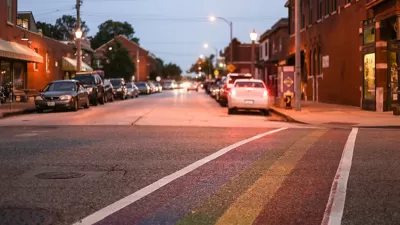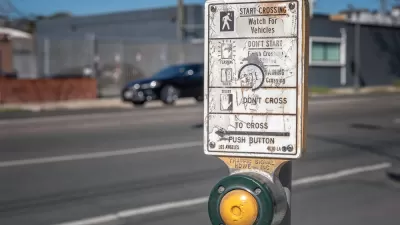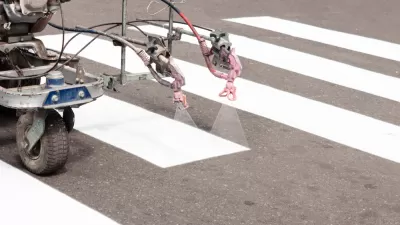There has been no shortage of responses to the story about St. Louis letting decorated sidewalks fade away after encountering federal policy that recommends more subdued colors.

Following news reported last weekend by the St. Louis Post-Dispatch that the city would let examples of decorated crosswalks fade away after determining they ran afoul of Federal Highway Administration policies, advocates and planners from around the country have spoken out.
First, Angie Schmitt responded with a pointed response to St. Louis, arguing that perhaps St. Louis Bike and Pedestrian Coordinator Jamie Wilson was being too stringent with his interpretation of the federal policy. Schmitt calls on an expert to show another way of responding to the policy:
Conor Semler, a planning consultant with the Boston-based firm Kittelson & Associates, said most cities he works with have interpreted the FHWA memo much differently. Cities like Baltimore — famous for its eye-catching zipper crosswalk — and Seattle have basically determined 'as long as the white transverse lines are clear, you can do almost anything inside that,' he said.
Speaking of Seattle, the Capitol Hill Times mobilized its staff in the wake of the story to follow up with Seattle Department of Transportation City Traffic Engineer Dongho Chang about the safety outcomes of the 11 rainbow crosswalks added to the neighborhood of Capitol Hill in the summer of 2015. According to the article, the crosswalks, "have not caused concerns from the city’s transportation department, clearing six months of review without a single pedestrian-involved collision."
FULL STORY: Get Real — Colorful Crosswalks Aren’t Endangering Pedestrians

Study: Maui’s Plan to Convert Vacation Rentals to Long-Term Housing Could Cause Nearly $1 Billion Economic Loss
The plan would reduce visitor accommodation by 25,% resulting in 1,900 jobs lost.

North Texas Transit Leaders Tout Benefits of TOD for Growing Region
At a summit focused on transit-oriented development, policymakers discussed how North Texas’ expanded light rail system can serve as a tool for economic growth.

Why Should We Subsidize Public Transportation?
Many public transit agencies face financial stress due to rising costs, declining fare revenue, and declining subsidies. Transit advocates must provide a strong business case for increasing public transit funding.

How to Make US Trains Faster
Changes to boarding platforms and a switch to electric trains could improve U.S. passenger rail service without the added cost of high-speed rail.

Columbia’s Revitalized ‘Loop’ Is a Hub for Local Entrepreneurs
A focus on small businesses is helping a commercial corridor in Columbia, Missouri thrive.

Invasive Insect Threatens Minnesota’s Ash Forests
The Emerald Ash Borer is a rapidly spreading invasive pest threatening Minnesota’s ash trees, and homeowners are encouraged to plant diverse replacement species, avoid moving ash firewood, and monitor for signs of infestation.
Urban Design for Planners 1: Software Tools
This six-course series explores essential urban design concepts using open source software and equips planners with the tools they need to participate fully in the urban design process.
Planning for Universal Design
Learn the tools for implementing Universal Design in planning regulations.
City of Santa Clarita
Ascent Environmental
Institute for Housing and Urban Development Studies (IHS)
City of Grandview
Harvard GSD Executive Education
Toledo-Lucas County Plan Commissions
Salt Lake City
NYU Wagner Graduate School of Public Service





























